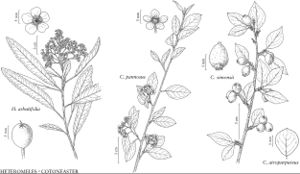Heteromeles
Fam. Nat. Syn. Monogr. 3: 100, 105. 1847.
| Taxon | Illustrator ⠉ | |
|---|---|---|
 | Heteromeles arbutifolia Cotoneaster pannosus Cotoneaster simonsii Cotoneaster atropurpureus | Marjorie C. Leggitt Marjorie C. Leggitt Marjorie C. Leggitt Marjorie C. Leggitt |
Shrubs or trees, canopies dense, 20–100 dm. Stems usually 1; bark (trunk) grayish, with fine tan to dark gray striations, ± smooth; short-shoots absent; unarmed; young stems puberulent. Leaves persistent, cauline, simple; stipules variably persistent, free, minute, margins unknown, apex gland-tipped; petiole present; blade ± elliptic to narrowly elliptic or narrowly oblong, 5–15 (–20) cm, leathery, margins revolute, sharply, remotely serrate, venation pinnate (craspedodromous-brochidodromous), surfaces tomentose when young, glabrescent. Inflorescences terminal, 20–150-flowered, panicles, ± dome-shaped, white-tomentose; bracts present on proximal nodes, leaflike, plus numerous, scalelike appendages on axes; bracteoles present caducous, delicate. Pedicels present. Flowers: perianth and androecium epigynous, 10 mm diam.; hypanthium urceolate, 2–4 mm, glabrous or weakly floccose; sepals 5, suberect, triangular; petals 5, white, irregularly round, base weakly clawed; stamens 10, shorter than petals; carpels 2 or 3, distinct, basally adnate to hypanthium, styles 2 or 3, lateral, distinct; ovules 2. Fruits pomes, usually bright red, sometimes yellow, ellipsoid, 5–10 mm, glabrous or glabrate; flesh mealy; hypanthium persistent; sepals persistent, accrescent over hypanthial opening. Pyrenes 2 or 3 per fruit, carpel walls thin, soft; styles not persistent; seeds 1 per pyrene, large.
Distribution
Calif., nw Mexico
Discussion
Species 1.
Heteromeles resembles Aronia and Photinia; it differs by having 10 stamens instead of 20, nearly free carpels (versus fully connate), and fruit flesh lacking stone cells (versus often possessing some). Its fruit is of the coreless type (J. R. Rohrer et al. 1991). Molecular evidence (D. Potter et al. 2007) shows a relationship to the Asiatic Eriobotrya and Rhaphiolepis Lindley miniclade; fruit type, notched petals, and other characteristics agree.
Selected References
None.
Lower Taxa
"thin" is not a number.